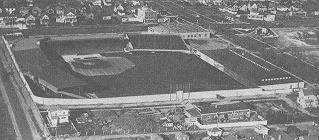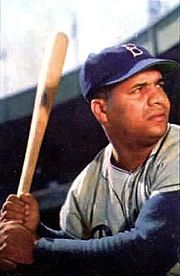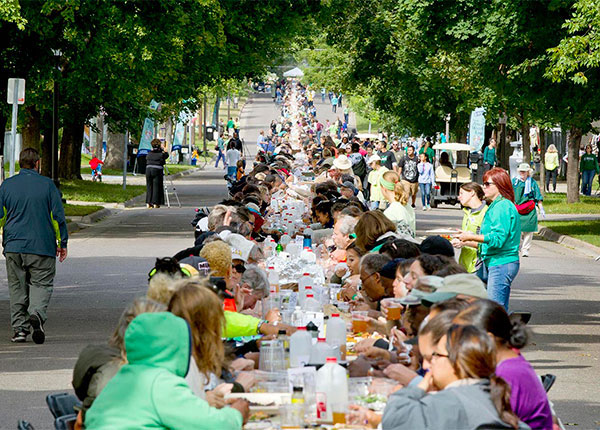The art elements at the Lexington Parkway Station reflect two aspects of Lexington Parkway. First, it is the only parkway that crosses the Green Line. To represent this green way compound leaves, like those found on the ash and hackberry trees that are planted on Lexington Parkway, are cut into the light poles entering the platforms. Also, hackberry leaves are presented on the large low-relief panels on the streetside of the stations. The second aspect is that Lexington and University was the home of Lexington Ballpark, home of the St. Paul Saints baseball team from 1897 - 1956. The light poles at the entrances to the platforms mimic the construction of the beams of the old ballpark and a low-relief panel depicting Roy Campanella's (St. Paul Saints, 1948) hands holding a baseball bat can be found on the sides of the utility cabinets.

Lexington Park, home of the St. Paul Saints from 1897-1956.

Roy Campanella with the Brooklyn Dodgers
Seitu Jones is a St. Paul public artist. Jones has created more than 30 large-scale public artworks and has created backdrops for numerous theaters in the Twin Cities.
In 2013, Jones envisioned and created the public artwork Create: The Community Meal, a half-mile long table, running down the middle of a neighborhood road, where 2,000 people sat down for a choreographed meal and conversation. Jones is very active in the broader community and his work often reflects his involvement in urban farming and food systems. He has created many backdrops for Penumbra Theater, where he is a company member.
In 2017, Jones received a McKnight Distinguished Artist Award. He has also been awarded a Minnesota State Arts Board Fellowship, a McKnight Visual Artist Fellowship, a Bush Artist Fellowship, a Bush Leadership Fellowship, a National Endowment for the Arts/Theater Communication Group (NEA/TCG) Designer Fellowship and a Loeb Fellowship at the Harvard Graduate School of Design. Jones was the first Artist-in-Residence for the City of Minneapolis and created artwork for three stations for the Greenline Light Rail Transit system in the Twin Cities.

The Community Meal, by Seitu Jones, Saint Paul, MN 2013
Poet Tou Saiko Lee’s poem, Universe on University Ave, appears on the railings of the platforms at Lexington Parkway.
Universe on University Ave
We live in an urban universe between street lights, stars, moons and stop signs.
Grow cilantro, sweet potatoes in the backyard, where survivors of war raise families.
Children draw hopscotch hieroglyphics on sidewalks with neon chalk.
We speak many tongues here.
Unified in this Universe on University Ave.
The following is taken from the Bush Foundation website:
As a teen, Tou SaiKo Lee wandered down a troubled path before creative writing saved his life. His travels to Thailand with his grandmother to learn from Hmong people living in mountain villages further fueled his passion for the arts and his culture. Today, he uses the arts to encourage cultural identity and pride in youth in the Frogtown neighborhood. Tou SaiKo Lee wants to expand his impact by becoming a more adept cultural liaison to the arts. He will use his Bush Fellowship to build skills in business management, and to return to Southeast Asia to grow his ability to capture elders’ stories and make them relevant to young people.